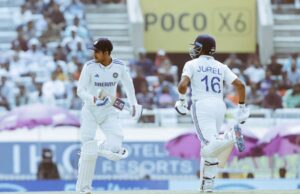
When Dhruv Jhuler sent India over the line with a two-man run in the fourth Test against England in Ranchi, Sunil Gavaskar chose to look beyond the moment of victory and peer into the future. .
“It's so nice to see young people celebrating by bringing India home. This will be a lifelong memory for them. The feeling you get when you have contributed to leading your country to victory. It's special. In the hands of these two youngsters (Jurel and Shubman Gill), Indian cricket will see many more wins over the next 15 years. Even more so as they are both in their early 20s. I will be playing for 15 years, if not more,” the legendary opener and former India captain said during the broadcast.
My mind flashed back to the BCCI email that arrived in my inbox a little over a month ago. As the five-Test series was about to begin, the board informed Virat Kohli of his withdrawal from the first two matches due to personal reasons. Kohli would eventually withdraw from the series, a decision that initially came as a shock. There was also a large gap in the mid-career ranks.
The Ajit Agarkar-led selection committee had the option of reconsidering the past and bringing back Cheteshwar Pujara. With his truckloads of experience and proven quality, his Pujara could have been an off-the-shelf solution. He had scored a lot of runs in the Ranji Trophy. Ajinkya Rahane, who led Mumbai in the country's premier red-ball domestic tournament, was also there. However, selectors and team management refused to look back in anticipation of the transition.
Due to his excellent performance in India A, Rajat Patidar was included in his place. Patidar's disappointment at Test level is a different matter, but the message from the Indian cricket system was loud and clear. Young people will be given preferential treatment.
India lost the first Test in Hyderabad and soon after came the news that KL Rahul and Ravindra Jadeja will miss the second Test in Visakhapatnam. Suddenly, India's batsmen were very thin in quality and experience. The selectors' response was to shun popular players and bring in Sarfaraz Khan, Washington Sundar and Sourav Kumar.
Jurrell was part of the original team despite having made just 15 first-class appearances before this Test series. When KS Bharat's batting became a matter of concern, the team management decided to slot the 23-year-old into the deep end. The bold call paid off. Youthful irreverence helped India secure a memorable series victory against England, who enjoyed a buzz-ball intensity.
Yashasvi Jaiswal, 22, has scored 655 runs in four Tests, including two double hundreds. Jurrell, 23, played two successful match-winning knocks only in the second Test. Sarfaraz, 26, made his impressive debut in Rajkot. Gill, 24, teetered on the edge and took some time to settle into third place. How well he recovered! Akash Deep, 27, has been given the impossible task of replacing Jasprit Bumrah. He took three wickets in the opening session of the fourth Test.
Enjoy our morning show:
Tea with RevSportz || Live https://t.co/PZjIozXHUB
— Boria Majumdar (@BoriaMajumdar) February 27, 2024
No wonder, then, that Rohit Sharma waxed lyrical about the young players after winning the series in Ranchi. “They have come in and done their job perfectly. They have accepted the responsibility perfectly and a performance like this from inexperienced players will be a matter of great pride,” the Indian captain said. He spoke at the post-match press conference.
This period of transition, 1996 to be precise, when Indian cricket went through a minor upheaval, has a mid-90s feel to it. Navjot Sidhu had a falling out with captain Mohammad Azharuddin during the Test series in England and was sent home. With Sanjay Manjrekar injured before the Test, the team had to rely on two young players – Sourav Ganguly and Rahul Dravid. India has acquired two players for the long term who will eventually serve as both captain and vice-captain and change the face of Indian cricket. VVS Laxman will be followed by Virender Sehwag, Yuvraj Singh, Zaheer Khan, Ashish Nehra and Harbhajan Singh.
The current young players, Jaiswal, Gir and Jhuler also give the feeling that they are here to stay. They are all works in progress and will ultimately be recognized for their overseas achievements in SENA (South Africa, England, New Zealand and Australia) countries. But there are high hopes for a group of young Turks who aspire to excel in Test cricket.
“Going forward, it's a big plus for us to have a lot of players come here and show that they belong here. I know it's still in the early stages, but they We have shown that we have all the capabilities and skills to be good in this format,” Rohit said.
On the fourth day of the Ranchi Test, when India were chasing a difficult target, head coach Dravid said two motivational words to his sons. If not now, then when? ” After the win, Gill shared it in an Instagram post. Young cannons stepped up to repay the faith of their coach. The transformation of Indian cricket has begun in earnest.
More sports information: https://revsports.in/

